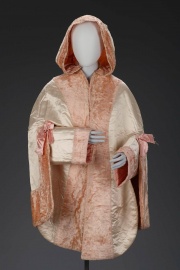Difference between revisions of "Satin weave"
Jump to navigation
Jump to search
m (Text replace - "\[http:\/\/cameo\.mfa\.org\/materials\/fullrecord\.asp\?name=([^\s]+)\s(.*)\]" to "$2") |
|||
| Line 1: | Line 1: | ||
| − | [[File:2002.699.1-SC63789.jpg|thumb|]] | + | [[File:2002.699.1-SC63789.jpg|thumb|Satin weave robe<br>MFA# 2002.699]] |
== Description == | == Description == | ||
| Line 13: | Line 13: | ||
</gallery> | </gallery> | ||
| − | + | == Resources and Citations == | |
| − | == | ||
* Hoechst Celanese Corporation, ''Dictionary of Fiber & Textile Technology'' (older version called Man-made Fiber and Textile Dictionary, 1965), Hoechst Celanese Corporation, Charlotte NC, 1990 | * Hoechst Celanese Corporation, ''Dictionary of Fiber & Textile Technology'' (older version called Man-made Fiber and Textile Dictionary, 1965), Hoechst Celanese Corporation, Charlotte NC, 1990 | ||
Revision as of 12:22, 19 October 2020
Description
One of three fundamental fabric weaving patterns: plain, satin, and twill. Satin weave is made by passing filling yarns over 1 warp yarn then under 4-12 warp yarns. The long filling threads, called floats, produce a smooth shiny surface, but are susceptible to snags. Examples of satin weave fabrics are Satin, Venetian cloth, and messaline.
See also Sateen weave.
Additional Images
Resources and Citations
- Hoechst Celanese Corporation, Dictionary of Fiber & Textile Technology (older version called Man-made Fiber and Textile Dictionary, 1965), Hoechst Celanese Corporation, Charlotte NC, 1990
- Rosalie Rosso King, Textile Identification, Conservation, and Preservation, Noyes Publications, Park Ridge, NJ, 1985
- Edward Reich, Carlton J. Siegler, Consumer Goods: How to Know and Use Them, American Book Company, New York City, 1937
- Hermann Kuhn, Conservation and Restoration of Works of Art and Antiquities, Butterworths, London, 1986
- Art and Architecture Thesaurus Online, http://www.getty.edu/research/tools/vocabulary/aat/, J. Paul Getty Trust, Los Angeles, 2000


